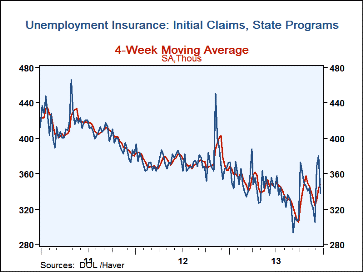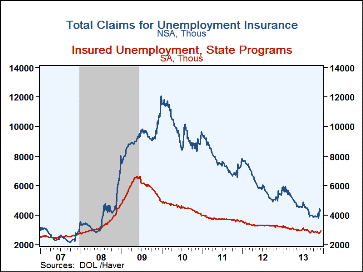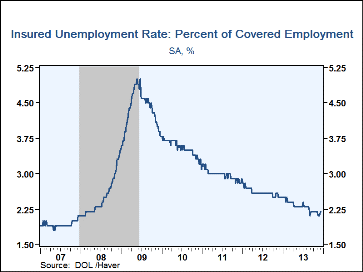 Global| Dec 26 2013
Global| Dec 26 2013U.S. Initial Claims for Unemployment Insurance Fall Back in Seasonal Volatility
Summary
Initial claims for unemployment insurance dropped to 338,000 last week following 380,000 in the week ended December 14, revised from 379,000. With the Thanksgiving-Christmas seasonality quirks, longer-term comparisons are perhaps more [...]
Initial claims for unemployment insurance dropped to 338,000 last week following 380,000 in the week ended December 14, revised from 379,000. With the Thanksgiving-Christmas seasonality quirks, longer-term comparisons are perhaps more informative: the year-on-year change is -7.7%. The four-week moving average of initial claims is 348,000, which is up from some recent readings, but doesn't indicate any sign of a trend change: see the accompanying graph. All this suggests some stability in labor market conditions. The Action Economics consensus survey shows that economists looked for a somewhat smaller drop in the weekly number to 350,000.
Continuing claims for unemployment insurance in the week ended December 14 rose to 2.923 million (-8.7% y/y). The four-week moving average rose to 2.837 million. The insured rate of unemployment remained at the prior week's 2.2%. This particular count covers only "regular" programs and does not include all extended benefit and other specialized jobless insurance programs. In the week of December 7, the latest available, the total of all benefit recipients increased to 4.412 million (-21.8% y/y). This broader measure is not seasonally adjusted. It compares to a cycle peak of 12.060 million in January 2010 and pre-recession figures that averaged 2.596 million in 2007. The number of individuals collecting emergency and extended payments in the week of December 7 eased back to 1.333 million (-36.4% y/y). It is this group of benefits that are due to expire with the December 28 week unless extended by Congress when it returns to session in early January.
Among individual states, the largest increases in initial claims for the week ending December 14 were in California (+4,622), Illinois (+3,686), Massachusetts (+2,331), Ohio (+1,529), and Indiana (+1,473), while the largest decreases were in New York (-12,706), Pennsylvania (-10,866), Georgia (-8,340), Texas (-4,904), and Wisconsin (-4,821). These data are also not seasonally adjusted.
Data on weekly unemployment insurance are contained in Haver's WEEKLY database and they are summarized monthly in USECON. Data for individual states are in REGIONW. The consensus estimates come from the Action Economics survey, carried in the AS1REPNA database.
| Unemployment Insurance (000s) | 12/21/13 | 12/14/13 | 12/07/13 | Y/Y % | 2012 | 2011 | 2010 |
|---|---|---|---|---|---|---|---|
| Initial Claims | 338 | 380 | 369 | -7.7 | 375 | 409 | 459 |
| 4-Week Average | 348 | 343.75 | 330.25 | -- | -- | -- | -- |
| Continuing Claims | -- | 2,923 | 2,877 | -8.7 | 3,319 | 3,742 | 4,531 |
| Insured Unemployment Rate (%) | -- | 2.2 | 2.2 | 2.5 (12/12) |
2.6 | 3.0 | 3.6 |
| Total "All Programs" (NSA) | -- | -- | 4.279 mil | -21.8 | 6.049 mil. | 7.724 mil. | 9.825 mil. |
Carol Stone, CBE
AuthorMore in Author Profile »Carol Stone, CBE came to Haver Analytics in 2003 following more than 35 years as a financial market economist at major Wall Street financial institutions, most especially Merrill Lynch and Nomura Securities. She had broad experience in analysis and forecasting of flow-of-funds accounts, the federal budget and Federal Reserve operations. At Nomura Securities, among other duties, she developed various indicator forecasting tools and edited a daily global publication produced in London and New York for readers in Tokyo. At Haver Analytics, Carol was a member of the Research Department, aiding database managers with research and documentation efforts, as well as posting commentary on select economic reports. In addition, she conducted Ways-of-the-World, a blog on economic issues for an Episcopal-Church-affiliated website, The Geranium Farm. During her career, Carol served as an officer of the Money Marketeers and the Downtown Economists Club. She had a PhD from NYU's Stern School of Business. She lived in Brooklyn, New York, and had a weekend home on Long Island.









